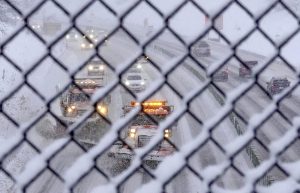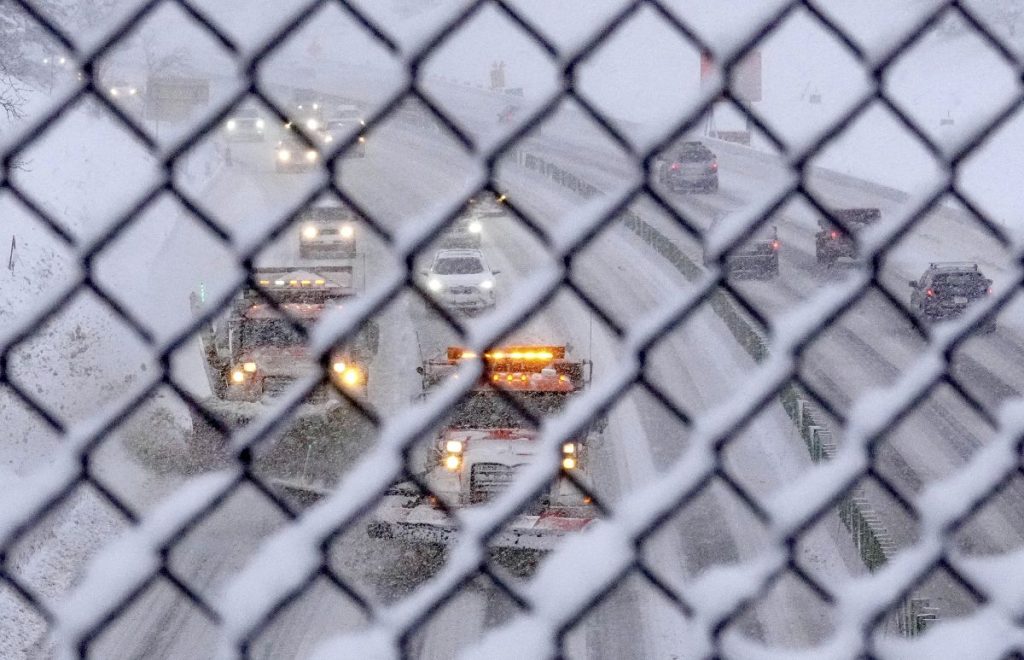California may get slammed by brutal storm front sweeping US
By AMANCAI BIRABEN and JIM SALTER Associated Press
PIERRE, S.D. (AP) — A brutal winter storm that trapped drivers on icy roads, blacked out hundreds of thousands of homes, grounded airplanes and closed schools across much of the country was poised to slam California Thursday.

Snow plows clear the highway along Interstate 80 on Wednesday, Feb. 22, 2023 in Salt Lake City, Utah. Brutal winter weather hammered the northern U.S. Wednesday with “whiteout” snow, dangerous wind gusts and bitter cold, shutting down roadways, closing schools and businesses and prompting dire warnings for people to stay home. (Francisco Kjolseth /The Salt Lake Tribune via AP)
“We are in for a VERY busy week!” the National Weather Service bureau in San Diego tweeted. “We have issued warnings for damaging winds, heavy mountain snow, highly hazardous boating conditions and the list goes on.”
For the first time since 1989, the weather service issued a blizzard warning for Southern California mountains that runs through Saturday. Some coastal areas could see 10-foot (3-meter) waves — and a few at up to 14 feet (4.3 meters) — through Thursday, forecasters said.
“Nearly the entire population of CA will be able to see snow from some vantage point later this week if they look in the right direction (i.e., toward the highest hills in vicinity),” UCLA climate scientist Daniel Swain tweeted Wednesday.
The storm, one in a series that was expected to pummel the country through the week, sowed chaos coast to coast. At one point Wednesday, more than 65 million people in more than two dozen states were under weather alerts.
The wintry mix hit hard in the northern U.S., closing schools, offices, even shutting down the Minnesota Legislature. About 90 churches in western Michigan canceled Ash Wednesday services, WZZM-TV reported.
In Wyoming, the state Transportation Department posted on social media that roads across much of the southern part of the state were impassable.
Rescuers tried to reach people stranded in vehicles but high winds and drifting snow created a “near-impossible situation” for them, said Sgt. Jeremy Beck of the Wyoming Highway Patrol.
“They know their locations, it’s just hard for them to get them,” he said.
In the Pacific Northwest, high winds and heavy snow in the Cascade Mountains prevented search teams from reaching the bodies of three climbers killed in an avalanche on Washington’s Colchuck Peak over the weekend.
Unexpectedly heavy snow during rush hour sent dozens of cars spinning out in Portland, Oregon, and caused hours-long traffic jams. The regional bus service offered free rides to warming shelters for homeless individuals.
In Arizona, about 180 miles (289 kilometers) of Interstate 40 were closed while state police in New Mexico shut down on-ramps in Gallup, just across the Arizona line.
The National Weather Service warned of the potential for blinding, wind-whipped snow, especially Thursday afternoon into the night when up to a half-inch (1.2 centimeters) per hour could fall.
In California, a blizzard warning was in effect through Saturday for higher elevations of the Sierra Nevada, where forecasters said conditions could include several feet of snow blown by 60-mph (96-kph) gusts and wind chill could drop the temperature to minus 40 degrees Fahrenheit (minus 40 Celsius).
In Sacramento, the state capital, the weather service said it had received reports of something that might be either hail or graupel — soft, wet snowflakes encased in supercooled water droplets.
Electrical grids took a beating as ice encrusted utility lines in the North and gusty winds knocked down lines or fouled them with tree branches and other debris in California.
A half-inch of ice covering a wire “is the equivalent of having a baby grand piano on that single span of wire, so the weight is significant,” said Matt Paul, executive vice president of distribution operations for Detroit-based DTE Electric.
More than 579,000 customers were without power in Michigan, well over 117,000 in Illinois and some 45,000 in California Wednesday night, according to the website PowerOutage.us.
Weather also contributed to nearly 1,800 U.S. flight cancellations, according to the tracking service FlightAware. Another 6,000-plus flights were delayed across the country.
At Denver International Airport, Taylor Dotson, her husband, Reggie, and their 4-year-old daughter, Raegan, faced a two-hour flight delay to Nashville on their way home to Belvidere, Tennessee.
Reggie Dotson was in Denver to interview for a job as an airline pilot.
“I think that’s kind of funny that we’ve experienced these types of delays when that’s what he’s looking into getting into now as a career,” Taylor Dotson said.
Few places were untouched by the wild weather, including some at the opposite extreme: long-standing record highs were broken in cities in the Midwest, mid-Atlantic and Southeast.
Nashville topped out Wednesday at 80 degrees Fahrenheit (26.67 degrees Celsius), breaking a 127-year-old record for the date, according to the weather service.
Indianapolis, Cincinnati, Atlanta, Lexington, Kentucky and Mobile, Alabama were among many other record-setters.
No warmup was forecast this week, though, in the northern U.S. More than 18 inches (46 centimeters) may pile up in parts of Minnesota and Wisconsin, the National Weather Service said Wednesday evening. According to the weather service, the biggest snow event on record in the Twin Cities was 28.4 inches (72 centimeters) from Oct. 31 through Nov. 3, 1991.
Temperatures could plunge as low as minus 20 degrees Fahrenheit (minus 29 degrees Celsius) Thursday and to minus 25 F (minus 32 C) Friday in Grand Forks, North Dakota. Wind chills may fall to minus 50 F (minus 46 C), said Nathan Rick, a meteorologist in Grand Forks.
The storm will make its way toward the East Coast later this week. Places that don’t get snow may get dangerous amounts of ice, forecasters warned.
___
Salter reported from O’Fallon, Missouri. Sarah Brumfield in Wyoming, Eugene Johnson in Seattle, Corey Williams in Detroit, Thomas Peipert in Denver, Brady McCombs in Salt Lake City, Utah, David Koenig in Dallas, John Antczak and Christopher Weber in Los Angeles, Gillian Flaccus in Portland, Ore., Julie Walker in New York, Amy Forliti in Minneapolis, and Steve Karnowski in St. Paul, Minnesota, contributed to this report.










